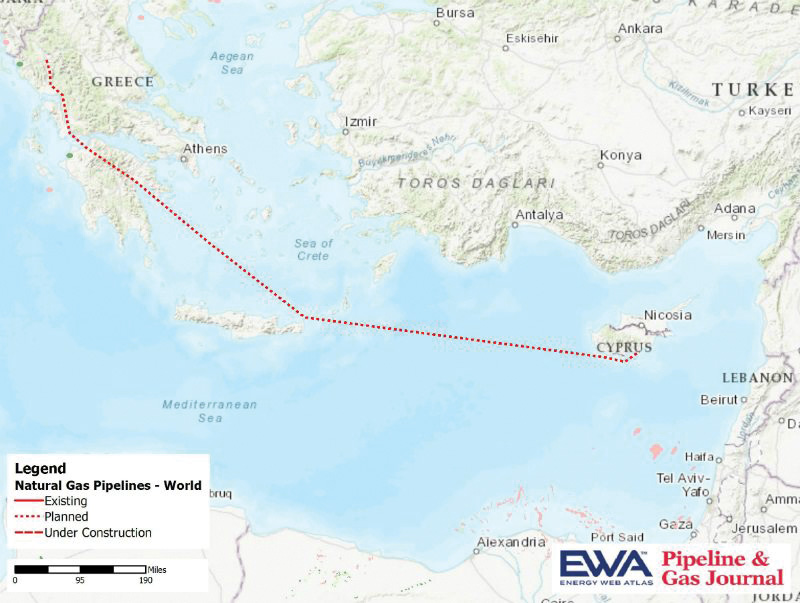September 2022, Vol. 249, No. 9
Features
DNV Confirms Feasibility, Maturity of EastMed Gas Pipeline
P&GJ Staff Report
DNV, the independent assurance and risk management provider, has issued confirmation of the feasibility statement of the Eastern Mediterranean Deepwater Pipeline (EastMed), a 1,343-mile (2,000-km) onshore and offshore natural gas project.
The EastMed pipeline would connect offshore gas reserves from the Levantine Basin to Greece via Cyprus, and further to southeastern European countries in conjunction with Poseidon and Greece-Bulgaria interconnection (IGB) pipelines.
The current design envisions an 870-mile (1,400-km) offshore and a 372-mile (600-km) onshore pipeline, with an initial capacity of about 353 Bcf/year (10 Bcm/year) of gas. The maximum water depth reached, for a short section of around 16 miles (10 km), is 1.86 miles (3,000 meters), which is in line with other ultra-deepwater pipelines already installed in other parts of the world.
“The EastMed Pipeline, together with Poseidon Pipeline, is the most mature project in the Mediterranean area, being now in the final engineering phase, and will reach the start of the commercial operation in 2027,” said Fabrizio Mattana, CEO of IGI Poseidon.
DNV reissued the feasibility statement following the assessment of the Front-End Engineering Design (FEED) documentation provided by IGI Poseidon S.A. This independent appraisal confirmed the technical maturity of the project and the benefits of the early involvement in the design activities of the offshore construction companies, thanks to competitive dialogue established under the ongoing tender process.
The unique context of this project in the Eastern Mediterranean region will allow it to help countries with coal- and heavy crude oil-reliant energy systems transition to cleaner natural gas to help reach their net-zero targets and strengthen energy security.
In particular, the EastMed Project, developed by IGI Poseidon S.A., is meant to respond to the specific needs of markets, such as Cyprus or some part of Greece, which are not tightly connected to the continent’s energy system and whose economies rely heavily on energy-intensive users like marine transport and international aviation.
The policy planning priorities laid out in several European Union (EU) members’ National Energy and Climate Plans (ENCP) identify both the reduction/removal of greenhouse gas emissions and supply security as priorities for their energy transition.
In line with these goals, the EastMed pipeline project was listed by the European Commission as a project of common interest (PCI), meaning cross-border projects identified as central for interconnecting the EU’s energy system infrastructure. It also has received grants from the Connecting Europe Facility (CEF) to carry out technical, economic and environmental/social impact assessments, including detailed seabed surveys.
Following recent route optimization and geophysical studies, DNV updated its report on the feasibility of the project, having issued a first one in 2020 covering the pre-FEED activities. Based on the assessment of the extensive design and survey campaign results performed by IGI Poseidon, DNV reviewed the project’s current status from a technical perspective and underlined points to be addressed as the project is completing its FEED phase.
“Projects like EastMed benefit from our extensive experience in technology development and verification of deep and ultra-deepwater gas pipeline projects throughout their lifecycle,” said Santiago Blanco, EVP for Southern Europe, Middle East, Africa and Latin America, Energy Systems at DNV.
IGI Poseidon SA is finalizing the development activities of the project and intends to reach the conditions required for a positive final investment decision during 2022.






Comments